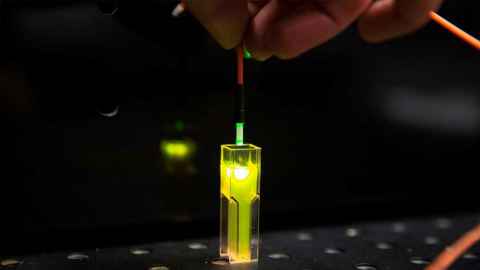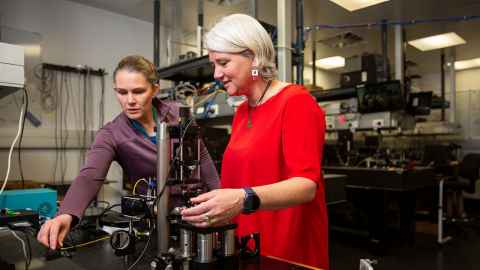Lighting the way with biophotonics
29 October 2021
Researchers in biophotonics tell us how they are using fundamental science to create solutions that improve food safety testing and reduce antibiotic resistance.
You may not have heard of biophotonics, but you’ve probably used it in everyday life, such as when you have an eye test with an optometrist. It’s an area of applied physics that uses light to understand biological systems.
Associate Professor Frédérique Vanholsbeeck (recipient of the New Zealand Association of Scientists’ Hill Tinsley Medal in 2020) and Dr Cushla McGoverin, from the Department of Physics are part of the University’s Biophotonics Research Group. They are also members of the Dodd-Walls Centre for Photonic and Quantum Technologies, a national Centre of Research Excellence operating across Aotearoa New Zealand.
Together with colleagues in microbiology, engineering and other disciplines, they’re working on a number of projects using light that could help solve some of the key problems facing societies at the moment.

Food safety under the spotlight
Frédérique and Cushla first started collaborating on a project called FoodSafe, with the idea to upgrade the way meat is tested for bacteria. The process currently takes up to two days, so their goal was to find a cost-effective way of counting bacteria in near real time. They aim to achieve this with fluorescence spectroscopy, a technique that employs dyes and light to measure the fluorescence of molecules.
Using this tool, they have found a way to detect a high concentration of bacteria rapidly. Cushla explains: “What we have at the moment is good for applications where you use microbes to make a product, for example in pharmaceuticals, fermentation or making yoghurt. It’s good for those high load applications. However, swab samples for meat or food safety applications in general need to detect low concentrations of bacteria, so we’re halfway there.”
The team are currently working on being able to count bacteria at mid and low concentration levels required for food safety testing in the food industry.
While they’ve been investigating the feasibility of using fluorescence spectroscopy for food safety, they’ve also learned a lot about the fundamentals of biophotonics that could be developed and applied to other settings. “While we pursue some very targeted research questions like ‘Is the water potable?’, we also learn a lot about bacteria and that allows a lot of fundamental science to occur,” says Frédérique. “It’s really good to maintain that pipeline between fundamental and applied research.”
Cushla agrees: “Just because you can’t see what the application of fundamental research would be straight away, doesn’t mean that it’s not good research. Fundamental research and blue sky thinking has a function.”
During the FoodSafe project, their team identified that the fluorescence spectroscopy method they used could measure concen-trations of bacteria, but couldn’t determine the species or whether bacteria are dead or alive. “The failure of the original idea is that we were detecting dead and alive bacteria alike,” says Frédérique. But a new research idea spun out of this original ‘failure’.

A lightbulb moment for antibiotic resistance?
Identifying whether bacteria are dead or alive is not easy. Different species thrive in different environments, some can ‘play dead’ or repair themselves when damaged, and others we don’t know enough about yet to determine the conditions they thrive or die in.
Craig Steed, a PhD student within the Biophotonics Research Group, is currently looking at whether there are any changes in cells that can clearly signal that they are dying. This fundamental research could have interesting applications in health settings, particularly in the area of antibiotic resistance.
Frédérique explains: “What we really want is to develop a rapid test, so you can prescribe the right antibiotic straight away, thereby decreasing the chance of antibiotic resistance. For example, respiratory diseases can be hard to target due to the mix or load of bacteria that causes them. In our ideal scenario, you would take a sample, inoculate it with antibiotics and see which one works best.
“It would be a rapid test because you often want to start treatment and stop the patients’ suffering as quickly as possible. This test could also be a good indicator to see whether bacteria have become resistant to a particular antibiotic.”
Cushla and Frédérique stress they’re not microbiologists, but are working closely with colleagues from the Faculty of Medical and Health Sciences at the University, particularly Associate Professor Simon Swift and Dr Julia Robertson who are affiliate members of the Biophotonics Research Group and lead the microbiology work.
“We’re learning so much, not just in our field but also from our colleagues,” says Frédérique. Cushla agrees that this collaboration has been great for “learning how to speak the same language. They learn a lot of physics and chemistry, and we learn a lot more about microbiology and medical practice.”
A lot of research successes come from something that didn’t work, so we need to have the time to investigate mistakes.
Shining a light on osteoarthritis
Another tool in the Biophotonics Research Group’s arsenal is optical coherence tomography (OCT), which uses light to capture 2D and 3D images. They have started a project with engineers and medical professionals to investigate non-communicable diseases.
Frédérique explains: “With non-communicable diseases, we don’t really know why or when you contract them. I’m starting to focus on osteoarthritis. One of the big questions is how it starts, in the bone or in the cartilage? We’re trying to understand how the disease develops to find a way of detecting it as early as possible. We’ll also try to find the right proxy so we can detect it in a non-invasive way, and early enough to prevent patients suffering.
“At the moment we are at the stage where we want to understand the mechanism of degeneration. We’re measuring the properties of cartilage and combining techniques to understand it better. We’re using OCT to look at the structure, and spectroscopy to measure the composition. At the same time we’ll compress the tissue and take measurements to better understand the biomechanics.
“Osteoarthritis is something that affects Māori people more than Pākehā, so later down the line we will have opportunities to involve and engage with communities.”
Looking towards a brighter future
Frédérique and Cushla both agree that solving problems is one of their favourite things about science. Cushla says, “it’s a puzzle. It requires a lot of thought. You come up with an idea. You think it will be obvious and fall into place and it doesn’t.”
They also agree that a lot of scientific solutions to global problems probably started out as a ‘failed’ piece of research. Frédérique thinks it’s important to be honest about failure. “A lot of research successes come from something that didn’t work, so we need to have the time to investigate mistakes. It’s also good to remember that research takes time to develop – we don’t have an exciting result every six months.”
What’s next on the horizon for Frédérique and Cushla? They’re using the knowledge they’ve gained so far about light and bacteria to start a new project creating sensors for water safety testing. They’ll also start involving industry and communities in refining solutions on their existing projects as they gather steam.
And with any luck, the next solution to a global problem could be one mistake away.
inSCight
This article appears in the 2021 edition of inSCight, the print magazine for Faculty of Science alumni. View more articles from inSCight.
Contact inSCight.